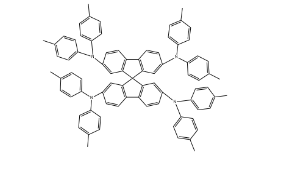
IdentificationPhysical DataSpectraRoute of Synthesis (ROS)Safety and HazardsOther Data
Identification
Product NameSPIRO-TTBIUPAC Name2-N,2-N,2-N',2-N',7-N,7-N,7-N',7-N'-octakis(4-methylphenyl)-9,9'-spirobi-2,2',7,7'-tetramineMolecular StructureCAS Registry Number 515834-67-0MDL NumberMFCD28968052SynonymsSPIRO-TTB515834-67-02,2',7,7'-Tetrakis(di-p-tolylamino)spiro-9,9'-bifluoreneN2,N2,N2',N2',N7,N7,N7',N7'-Octa-p-tolyl-9,9'-spirobi-2,2',7,7'-tetraamine2,2',7,7'-tetra(N,N-di-p-tolyl)amino-9,9-spirobifluoreneSpiro-TTB , 2,2',7,7'-tetra(N, N-di-tolyl)aMino-spiro-bifluorSCHEMBL133508CS-03788272,2',7,7'-tetra(N,N-ditolyl)amino-9,9-spiro-bifluorene2,2',7,7'-Tetrakis(di-4-methylphenylamino)-9,9'-spirobifluorene2,2',7,7'-Tetrakis-9,9'-spirobi2-N,2-N,2-N',2-N',7-N,7-N,7-N',7-N'-octakis(4-methylphenyl)-9,9'-spirobi-2,2',7,7'-tetramineMolecular FormulaC81H68N4Molecular Weight1097.4InChIInChI=1S/C81H68N4/c1-53-9-25-61(26-10-53)82(62-27-11-54(2)12-28-62)69-41-45-73-74-46-42-70(83(63-29-13-55(3)14-30-63)64-31-15-56(4)16-32-64)50-78(74)81(77(73)49-69)79-51-71(84(65-33-17-57(5)18-34-65)66-35-19-58(6)20-36-66)43-47-75(79)76-48-44-72(52-80(76)81)85(67-37-21-59(7)22-38-67)68-39-23-60(8)24-40-68/h9-52H,1-8H3 InChI KeyVMPLMOXGWULJTH-UHFFFAOYSA-N Canonical SMILESCC1=CC=C(C=C1)N(C2=CC=C(C=C2)C)C3=CC4=C(C=C3)C5=C(C46C7=C(C=CC(=C7)N(C8=CC=C(C=C8)C)C9=CC=C(C=C9)C)C1=C6C=C(C=C1)N(C1=CC=C(C=C1)C)C1=CC=C(C=C1)C)C=C(C=C5)N(C1=CC=C(C=C1)C)C1=CC=C(C=C1)C
Patent InformationPatent IDTitlePublication Date TW2021/10788Electronic device 2021US2019/51843ORGANIC ELECTROLUMINESCENT MATERIALS AND DEVICES2019KR2016/39625ORGANIC ELECTROLUMINESCENCE COMPOSITION, MATERIAL FOR ORGANIC ELECTROLUMINESCENCE ELEMENT, SOLUTION OF MATERIAL FOR ORGANIC ELECTROLUMINESCENCE ELEMENT, AND ORGANIC ELECTROLUMINESCENCE ELEMENT2016 US2016/240800ORGANIC ELECTROLUMINESCENT MATERIALS AND DEVICES2016
Physical Data
AppearanceWhite powder
Spectra
Description (NMR Spectroscopy)Nucleus (NMR Spectroscopy)Solvents (NMR Spectroscopy)Frequency (NMR Spectroscopy), MHzChemical shifts1Hchloroform-d1400Chemical shifts13Cchloroform-d1101
Description (UV/VIS Spectroscopy)Solvent (UV/VIS Spectroscopy)Comment (UV/VIS Spectroscopy)Absorption Maxima (UV/VIS), nmSpectrumfilm386Spectrumtetrahydrofuran385
Route of Synthesis (ROS)
Route of Synthesis (ROS) of SPIRO-TTB CAS 515834-67-0
ConditionsYieldWith tri-tert-butyl phosphine; palladium diacetate; sodium t-butanolate In toluene at 115℃; for 12h;85%
Safety and Hazards
No data available
Other Data
TransportationUnder room temperature away from lightHS CodeStorageUnder room temperature away from lightShelf Life2 yearsMarket Price
DruglikenessLipinski rules componentMolecular Weight1097.46logP24.514HBA4HBD0Matching Lipinski Rules2Veber rules componentPolar Surface Area (PSA)12.96Rotatable Bond (RotB)12Matching Veber Rules1
Use PatternSPIRO-TTB CAS: #515834-67-0 is used as an emissive layer material in OLEDs and OPVs. In OLEDs, it serves as an electron transport material and an emitter, converting electrical energy into visible light through electroluminescence. In OPVs, Spiro-TTB functions as a photoactive material, facilitating the conversion of light energy into electrical energy.The incorporation of Spiro-TTB in OLEDs and OPVs can improve device efficiency. In OLEDs, it provides efficient electron transport and emissive properties, enhancing the device's luminescence efficiency and charge injection balance. In OPVs, the photoactive performance of Spiro-TTB helps to increase the device's solar energy conversion efficiency.And Spiro-TTB exhibits good photostability and long lifespan characteristics, contributing to the extended operation of OLEDs and OPVs. This is due to the structural stability and antioxidative properties of Spiro-TTB, allowing it to resist the impact of external factors such as light exposure, humidity, and oxygen.
https://www.chemwhat.com/spiro-ttb-cas-515834-67-0/
Comments
Post a Comment